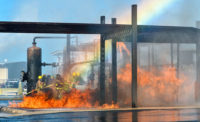Each day about 2,000 U.S. workers have a job-related eye injury that requires medical treatment, according to NIOSH. About one-third of the injuries are treated in hospital emergency departments and more than 100 of these injuries result in one or more days of lost work. While vision loss is one of the 10 most common disabilities, 90 percent of eye injuries are preventable, according to NIOSH.
Most of these injuries result from small particles or objects striking or abrading the eye. Examples include metal slivers, wood chips, dust, and cement chips that are ejected by tools, wind blown, or fall from above a worker. Chemical burns to one or both eyes from splashes of industrial chemicals or cleaning products are common. Thermal burns to the eye occur as well.
Infectious contamination
In addition to common eye injuries, health care workers, laboratory staff, janitorial workers, animal handlers, and other workers may be at risk of acquiring infectious diseases via ocular exposure. Infectious diseases can be transmitted through the mucous membranes of the eye as a result of direct exposure (e.g., blood splashes, respiratory droplets generated during coughing or suctioning) or from touching the eyes with contaminated fingers or other objects. The infections may result in relatively minor conjunctivitis or reddening/soreness of the eye or in a life threatening disease such as HIV, B virus, or possibly even avian influenza.
What should be done in an eye emergency?
Seek medical attention as soon as possible following an injury, particularly if you have pain in the eye, blurred vision or loss of any vision, according to the American Optometric Association (AOA). Here are first aid steps recommended by the AOA to take until medical assistance is obtained:
First aid for chemicals in the eye:
- Immediately flush the eye with water for at least 15 minutes. Place the eye under a faucet or shower.
- If you are wearing contact lenses, immediately remove them before flushing the eye.
- Do not try to neutralize the chemical with other substances.
- Do not bandage the eye.
- Seek immediate medical attention after flushing.
First aid for particles in the eye:
- Do not rub the eye.
- Try to let your tears wash the speck out, or irrigate the eye with an artificial tear solution.
- Try lifting the upper eyelid outward and down over the lower eyelid to remove the particle.
- If the particle does not wash out, keep the eye closed, bandage it lightly and seek medical care.
Some particles, particularly metallic ones, can cause rusting spots on the eye if left untreated for several days. If you are unsure if the object is gone, do not delay medical care.
First aid for blows to the eye:
- Gently apply a cold compress without putting pressure on the eye. Crushed ice in a plastic bag can be placed gently on the injured eye to reduce pain and swelling.
- In cases of severe pain or reduced vision, seek immediate medical care.
- First aid for cuts and punctures to the eye or eyelid:
- Do not wash out the eye.
- Do not attempt to remove an object that is stuck
- in the eye.
- Cover the eye with a rigid shield, like the bottom half of a paper cup.
- Seek immediate medical care.
Flushing your eye
Flushing your eye may help relieve mild eye symptoms and is the most important first aid measure for a chemical substance in the eye, according to WebMD. The sooner you get a chemical out of the eye, the less damage it may do.
If you are wearing contacts, remove them before flushing your eye. If you are not able to remove a contact, flush your eye with the contact in, says WebMD.
Flush the eye from the inner corner toward the outer corner. This prevents a substance in the eye from washing into the other eye. Flushing the eye will be easier if you have someone who can help you.
Here are steps recommended by the Mayo Clinic:
- Wash your hands with soap and water.
- Try to flush the object out of your eye with a gentle stream of clean water.
- Another way to flush a foreign object from your eye is to get into a shower and aim a gentle stream of water on your forehead over the affected eye while holding your eyelid open.
- If you're wearing contact lenses, it's best to remove the lens before or while you're irrigating the surface of the eye with water. Sometimes a foreign body can be embedded on the undersurface of the lens.
This information is not intended to replace the advice of a doctor. It is solely an overview. Emergency eye care calls for training & communicating with medical specialists.




